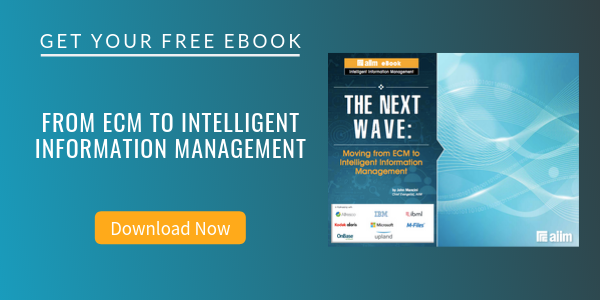
2016 Round-Up – Top 10 Must-Read Content Management Posts
Enterprise Content Management (ECM) | Intelligent Information Management (IIM)
Here’s the list you’ve been waiting for – the top 10 Digital Landfill posts in 2016.
1. Some Perspectives on the Documentum Acquisition by OpenText
Well, the other shoe called Documentum dropped that everyone was expecting once Dell and EMC got together. And in somewhat record speed. AIIM does not take positions on things like acquisitions, but obviously, the extended AIIM community is buzzing about this. I thought I would find as many articles as I could and put them in one place and let folks form their own opinions.
2. Current State and Future Trends in Enterprise Content Management [Infographic]
Information management is boldly on the horizon. Everyone from C-level thought leaders to end users are dreaming up enterprise content management possibilities and asking an important question: how can my organization go beyond its current ECM state? In order to determine which enterprise content management component(s) an organization requires to take the next step in their ECM capability– whether it be a technology, methodology, or human resource – begins with taking stock of what is already in place; only then, can it be resolved where we are currently, and where we desire to go in the enterprise content management space.
3. EU Regulation eIDAS: what it means for your business in Europe
Today the use of E-Signatures is an acceptable business practice that is admissible in times of litigation and audit. The key to success is to identify and understand regulations based on particular business processes for E-Signing. In Europe, one regulation is changing the game. Effective July 2016, the new EU regulation on electronic identification and trust services 910/2014 – typically referred to as eIDAS - goes into force. It is designed to propel digital transformation as a major cornerstone for a single European Market. One of its major goals is to fuel E-Signature adoption in Europe by largely replacing 28 nation laws on E-Signatures. eIDAS comes with new options to go digital with both identification and signing processes.
4. 5 Examples of Digital Disruption -- the Flip Side of Digital Transformation
I've been collecting examples of "Digital Disruption" -- the negative flip side of Digital Transformation. In other words, examples in which a well-entrenched incumbent just failed to see the writing on the wall. My experience has been that when Digital Disruption sweeps through an industry, it usually meets this test: In less than 10 years, 90% of a company's/industry's value DISAPPEARS. Here are just five examples.
5. The Journey to Simpler Information Management Begins With Going Paperless
In pursuit of the paperless enterprise, it is often easy to lose our way. Projects stall, months pass, and ROI is nowhere on the horizon, and all the while paper continues to rifle through our processes like stubborn weeds. Paper overwhelms the enterprise, and the difficult task to remove it all can cause a crisis of motivation. Stakeholders ask: “What is the point of driving out paper? What destination is this digital journey leading us to? And is it worth it?” The short answer: yes, and here’s why.
6. The Problem with SharePoint - Technology or People?
I hear people from around the globe, complain about SharePoint that it doesn’t do this, or we thought it did that. Yet the AIIM Industry Watch Report titled “The Impact of SharePoint 2016” finds when it comes to SharePoint meeting organizational expectations, nearly half of our respondents are happy with SharePoint and the on-going product roadmap, with half also in agreement that SharePoint is providing good value for the cost. Typically, these organizations have a focused plan, working as a cross-functional team rather than total reliance on IT to make it all happen. This should also be an on-going practice for every aspect of a SharePoint project from initial purchase through upgrades and expansion, to ensure SharePoint is addressing the business needs and solving business problems, and not put in place for technology sake alone.
7. 8 Reminders About Why World Paper Free Day Matters
Here are 8 paper-free nuggets to get the juices flowing. Number 1 -- Paper in the Office -- only 17% of respondents work in what could be described as a paper-free office. 31% admit their office is piled high with paper documents and paper processes. 40% still use paper for filing “important stuff," and 56% are wed to signatures on paper for contracts and order forms.
8. Is BPM the Digital Transformation Enabler? [Infographic]
Agility and efficiency have become the keys to meeting the growing and changing demands that come with digital disruption. Businesses can no longer afford to waste time with lengthy business analysis, development, and implementation projects spanning two or more years. Organization leaders know that change must occur rapidly to remain competitive, retain current clients, and attract new business, and BPM has become the method of choice. Business Process Management (BPM), in a true sense, is the combination of process, people, information, and technology focused on resolving operational business problems – making businesses run more effectively.
9. 12 Things You Can Do NOW to Use BPM to Drive Digital Transformation
Process improvement and automation using BPM as the framework is an essential part of the Digital Transformation of businesses. The more paper is eliminated from processes and digitally born information is created, the greater the dependence upon and need for efficient, effective, and secure digital workflows. When assessing process improvement and automation opportunities, include the identification of and ways various information sets are integrated with the process and remember to look at the end-to-end process, rather than just the departmental workflow. What gets changed in the department could have a negative impact on other departments feeding this process or that this process feeds.
10. 8 Things You Must Know to Automate Human Resource Processes
It is the best of times and the worst of times for HR professionals. Many organizations have reaped enormous benefits from more effectively managing the unstructured information association with core Human Resources processes. That’s the good news. The bad news is that MOST organizations have not yet moved down the path of HR automation, creating huge inefficiencies and risks in their hiring, retaining, employee servicing and firing practices. Consider for a moment the huge variety and volume of documents associated with HR processes, each of which carries with it different regulatory and legal requirements.
Watch this space for a lot of exciting new developments for our blog in 2017.
About John Mancini
John Mancini is the President of Content Results, LLC and the Past President of AIIM. He is a well-known author, speaker, and advisor on information management, digital transformation and intelligent automation. John is a frequent keynote speaker and author of more than 30 eBooks on a variety of topics. He can be found on Twitter, LinkedIn and Facebook as jmancini77. Recent keynote topics include: The Stairway to Digital Transformation Navigating Disruptive Waters — 4 Things You Need to Know to Build Your Digital Transformation Strategy Getting Ahead of the Digital Transformation Curve Viewing Information Management Through a New Lens Digital Disruption: 6 Strategies to Avoid Being “Blockbustered” Specialties: Keynote speaker and writer on AI, RPA, intelligent Information Management, Intelligent Automation and Digital Transformation. Consensus-building with Boards to create strategic focus, action, and accountability. Extensive public speaking and public relations work Conversant and experienced in major technology issues and trends. Expert on inbound and content marketing, particularly in an association environment and on the Hubspot platform. John is a Phi Beta Kappa graduate of the College of William and Mary, and holds an M.A. in Public Policy from the Woodrow Wilson School at Princeton University.



